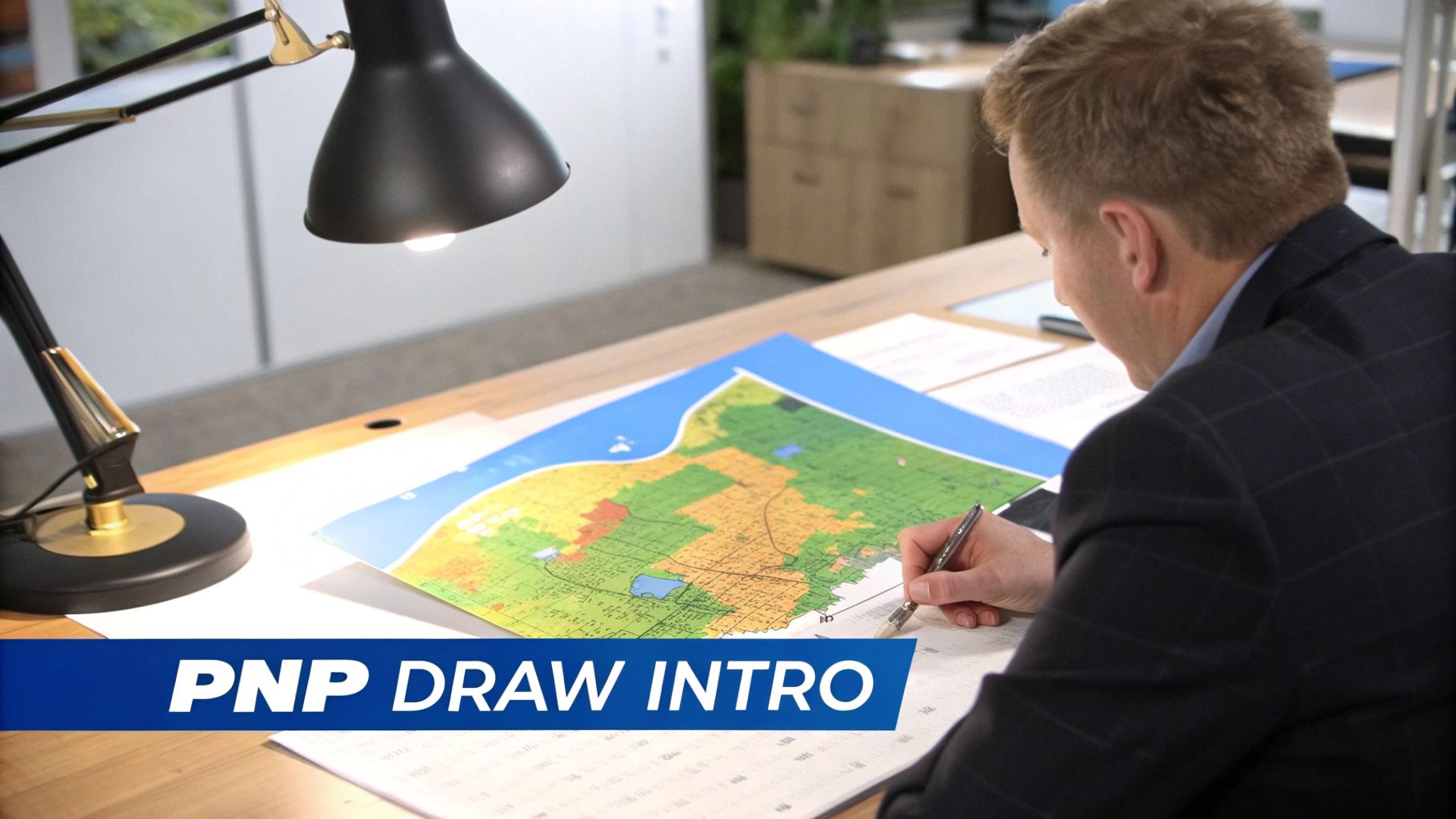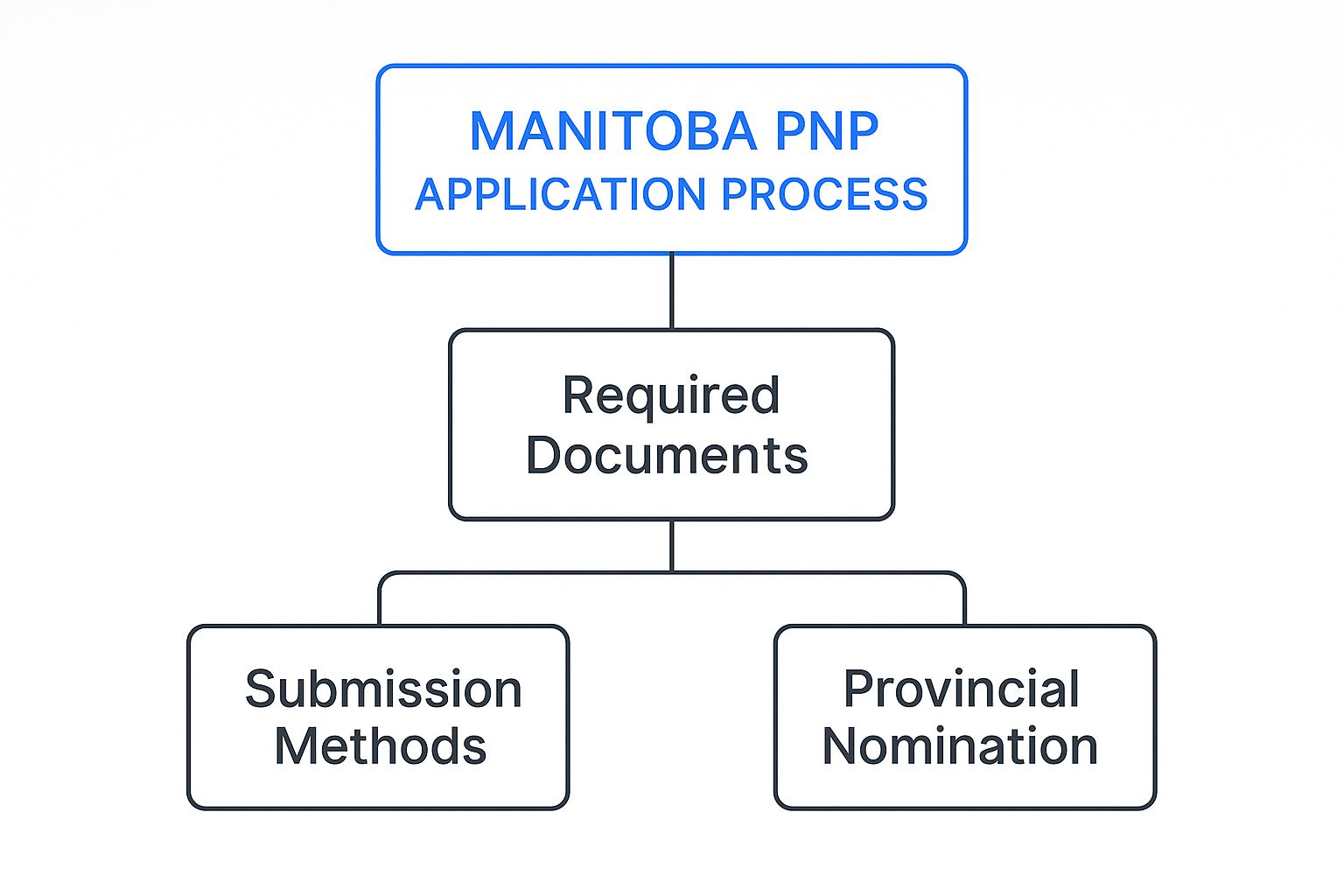Manitoba Provincial Nominee Program Draw Guide

A Manitoba Provincial Nominee Program draw is essentially an invitation round. The Manitoba government regularly dips into its pool of immigration hopefuls and picks the ones who best fit the province's needs at that moment. These draws are how they select candidates with the highest scores and most in-demand skills to formally apply for a provincial nomination.
Think of it as Manitoba’s system for hand-picking the exact talent it needs to fuel its economy and fill gaps in the job market.
How the Manitoba PNP Draw Really Works

Picture a huge, exclusive talent pool filled with skilled professionals who all want to make Manitoba their new home. This is the Expression of Interest (EOI) pool. A Manitoba PNP draw is the moment the doors swing open, but only for a specific group of people whose profiles are a perfect match for what the province is looking for right then and there.
Just being eligible and waiting in the pool isn't enough. To get that coveted invitation, you have to stand out from the crowd.
From Candidate Pool to Invitation
The whole system runs on points. When you create and submit your EOI profile, you're given a score based on things like your age, education, language skills, and work history. This score is your ranking in the pool.
The goal isn't just to qualify; it's to outrank other candidates. A higher score dramatically increases your chances of receiving a Letter of Advice to Apply (LAA)—the official golden ticket from the MPNP.
These draws happen regularly, ensuring a steady stream of newcomers who can hit the ground running and contribute to the local economy. They aren't random lotteries; they're incredibly strategic. For example, one draw might focus on tech professionals, while the next might target candidates with a family connection in Manitoba. Getting a firm grip on this process is your first step to a successful application. For a deeper dive into the program's nuts and bolts, check out our comprehensive guide on the Manitoba Provincial Nominee Program.
The Importance of Being Competitive
The system is built to be flexible and responsive to the province's real-time labour market gaps. This means the selection criteria can, and often do, change from one draw to the next.
So, what makes a profile truly competitive?
- A High Ranking Score: This is your most critical asset. It directly determines your place in the queue.
- An In-Demand Occupation: If your work experience is on Manitoba’s list of needed jobs, you've got a massive advantage.
- Strong Manitoba Connection: Things like having a close relative living in the province or previous work experience there can seriously boost your score and show you're ready to adapt.
At the end of the day, every Manitoba PNP draw is a calculated move to fill a specific need. That’s why it’s so important for you, as an applicant, to build the strongest, highest-scoring profile you possibly can.
Getting to Know the Main MPNP Immigration Pathways

Think of the Manitoba Provincial Nominee Program (MPNP) as a building with several different doors. Each door—or 'stream'—is designed for a specific type of person. Picking the right one isn't just a good idea; it's essential for your success. Your entire application hinges on choosing the stream that perfectly matches your unique background, skills, and connections to the province.
Let's walk through these main pathways together. Understanding them is the first real step on your journey, helping you figure out where you fit and which route offers the best shot at getting that coveted invitation from a Manitoba Provincial Nominee Program draw.
Skilled Worker in Manitoba Stream
This stream is exactly what it sounds like: it’s for skilled individuals who are already in Manitoba and working. If you're a temporary foreign worker or an international student graduate with a full-time, long-term job offer, this is almost certainly your most direct path to nomination.
You could call it the "insider track." You've already proven you can contribute to a Manitoba business and are settled into the local economy.
To qualify, you generally need to have:
- A long-term, full-time job offer from the Manitoba company you're currently working for.
- Worked continuously for that employer for at least six months.
- All the required qualifications, licenses, or certifications for your position.
- A solid settlement plan that shows you're serious about building your life in Manitoba.
Essentially, this stream gives priority to people who have already put down roots and shown they can thrive in the Manitoba job market.
Skilled Worker Overseas Stream
But what if you're not in Manitoba yet? That's where the Skilled Worker Overseas stream comes in. This pathway is for qualified candidates who, despite being abroad, can show a strong, established connection to the province. It operates on a points-based system where your links to Manitoba are a huge factor.
So, what counts as a strong connection? It usually comes in one of two forms:
- Manitoba Support: This is when you have a close friend or relative (your "Manitoba Supporter") who is a permanent resident or citizen and has lived in the province for at least one year.
- Manitoba Experience: This applies if you have previously studied or worked in Manitoba.
On top of this, the MPNP sometimes runs Strategic Recruitment Initiatives. Think of these as special missions where the province directly invites people with specific skills to apply, sometimes even if they don't have a family connection.
This pathway is all about demonstrating you have a genuine, tangible link that will help you settle in successfully. It shows the government you already have a support network or are familiar with the province, which makes your transition much easier.
International Education Stream
Manitoba invests in world-class education, and it wants to keep the talent it helps create. The International Education Stream is designed specifically for recent graduates from Manitoba’s post-secondary institutions, offering them a faster track to nomination.
This stream is broken down into three distinct pathways:
- Career Employment Pathway: For graduates who have secured a long-term job in an in-demand field related to what they studied.
- Graduate Internship Pathway: Aimed at Master's and PhD graduates who complete a qualifying internship through Mitacs, a national research organisation.
- Student Entrepreneur Pathway: For entrepreneurial graduates from Manitoba institutions who want to launch and run their own business in the province.
Each of these streams is a clear door into Manitoba. The Skilled Worker in Manitoba is for those already contributing on the ground, the Skilled Worker Overseas is for those with deep-rooted connections, and the International Education Stream is a reward for those who chose to build their academic foundation in the province.
Decoding the MPNP Points and Ranking System
Your path to a Manitoba Provincial Nominee Program draw is really a numbers game. At the end of the day, your success hinges on a single number: your ranking score. This score determines where you stand in the competitive Expression of Interest (EOI) pool, so understanding how it’s calculated is the first, most critical step.
Think of your EOI profile as a scorecard that tells the Manitoba government how likely you are to succeed and settle in the province. The MPNP awards points for a handful of key factors, what they call "Core Human Capital", which are essentially the building blocks of your final score.
The Core Human Capital Factors
The points system is refreshingly straightforward, letting you see exactly what your strengths are and where you might need to improve. Points are handed out for:
- Language Proficiency: This is a big one. Strong English or French skills are non-negotiable. The higher your Canadian Language Benchmark (CLB) score, the more points you'll rack up.
- Age: Candidates in their prime working years, usually between 25-35, tend to earn the most points here. The number of points gradually decreases for older applicants.
- Work Experience: The more years you’ve spent working in a skilled occupation, the better. More experience directly translates to more points.
- Education: From a high school diploma right up to a PhD, your educational background plays a significant role in your total score.
The whole idea is to show you can hit the ground running and contribute to Manitoba's economy and community. Your score is what makes the difference between you and another candidate receiving that coveted invitation.
This diagram gives a great high-level view of the entire MPNP application process, starting from getting your documents in order all the way to securing a nomination.

As you can see, a successful provincial nomination is the final piece of the puzzle before you move on to your federal application.
Understanding Adaptability and Cut-Off Scores
Now, here's where it gets interesting. Beyond those core factors, the MPNP has a unique set of "Adaptability" points. These can be absolute game-changers, giving you a serious boost for having existing ties to Manitoba.
You can earn these crucial extra points for things like having a close relative already living in the province, previous work experience in Manitoba, or even having studied there in the past. These connections prove you're more likely to settle down for the long haul.
This all leads to the cut-off score. For every single draw, the MPNP establishes a minimum score needed to get a Letter of Advice to Apply (LAA). If your score is at or above that number, you're in! If it's below, you stay in the EOI pool, hoping for a lower cut-off in the next draw. By keeping an eye on recent trends, you can gauge how competitive your profile really is.
For a deeper dive into the specific requirements, you can learn more about what it takes to get a Manitoba provincial nomination.
Analysing MPNP Draw Frequency and Trends
One of the first questions people ask is, "How often does Manitoba hold a draw?" It’s a natural thing to wonder, but the Manitoba Provincial Nominee Program draw doesn't run on a predictable schedule like a train. Think of it less like a timetable and more like a response system.
Draws are held whenever Manitoba needs to fill specific gaps in its economy or has the capacity to process a new batch of applications. This could mean draws happen weekly for a stretch, then bi-weekly, or even monthly. This flexible approach lets the province be nimble, picking candidates with the skills it needs right now. For you, this means staying on top of the latest news is crucial for managing expectations.
Tracking Draw Patterns and Cut-Off Scores
The number everyone watches is the cut-off score – the minimum score needed to get an invitation in a particular draw. This isn't a static figure; it bounces around with every Manitoba Provincial Nominee Program draw and is different for each stream. A draw for Skilled Workers already in Manitoba will likely have a different score requirement than one for Skilled Workers Overseas.
By keeping an eye on these trends, you get a real-world benchmark for your own profile. If the cut-off scores have been consistently high, that’s your cue to find ways to boost your points. On the flip side, a sudden drop in scores might just be the opportunity you’ve been waiting for.
Understanding these patterns isn't about perfectly predicting the future. It's about making smart, informed decisions with real data, so you know when your profile is at its most competitive.
The Rise of Targeted Draws
Lately, Manitoba has shifted heavily towards targeted draws. Instead of opening the floodgates to everyone, the province frequently sends out Letters of Advice to Apply (LAAs) to people in specific occupations. One draw might be looking for transport truck drivers, while the next is entirely focused on healthcare aides or welders.
What’s interesting is that these occupation-specific draws can have different, and sometimes lower, score requirements than the all-program rounds. This really shows how Manitoba uses immigration as a precision tool to solve immediate labour shortages.
Just look at the numbers. In 2023, Manitoba nominated a whopping 9,540 skilled immigrants, using its full federal allocation and then some. This was a huge leap from 6,325 nominations in 2022, a jump driven almost entirely by the need to fill critical jobs. And they aren't slowing down. Manitoba is now aiming for an even bigger allotment of 12,000 nominations for 2025, which signals a continued reliance on this strategic approach. You can discover more insights about these nomination figures and what they mean for the province's economy.
This targeted strategy also influences where new immigrants settle. The data from 2023 shows a clear pattern of nominees heading towards established economic centres.
Nominee Destination Hubs in Manitoba
This table shows the primary cities and regions where skilled worker nominees intended to settle in 2023, highlighting the concentration in key economic areas.
| Destination City/Region | Percentage of Nominees |
|---|---|
| Winnipeg | 71% |
| Brandon | 9% |
| Winkler | 4% |
| Steinbach | 3% |
| Neepawa | 2% |
| Morden | 2% |
| Other Rural Communities | 9% |
As you can see, while Winnipeg remains the primary destination, a significant number of skilled workers are also choosing to build their lives in other vital regional hubs across the province, filling jobs where they are needed most.
How to Boost Your Score for the Next MPNP Draw

Understanding how the points system works is the first step, but actively improving your score is how you get selected. If your current Expression of Interest (EOI) score isn't quite clearing the bar set in recent draws, don't worry. Your profile isn't set in stone; think of it as a living document with several key areas you can work on to gain those vital extra points.
This is your game plan for turning a decent profile into an irresistible one. By zeroing in on specific, achievable goals, you can seriously improve your chances in the next Manitoba Provincial Nominee Program draw. Let’s dive into the most effective strategies.
Sharpen Your Language Skills
Your language proficiency is one of the most powerful tools in your arsenal. The points system gives significant weight to language skills, and even a slight improvement in your test scores can make a huge difference to your EOI ranking.
Aiming for a higher Canadian Language Benchmark (CLB) level on your IELTS, CELPIP, or TEF exam is one of the most direct ways to earn more points. Look into a prep course or set aside daily study time to hammer out practice tests. Pinpointing and improving your weakest areas—whether that’s writing, speaking, or comprehension—can help you jump up a CLB level and see a real bump in your score.
Add to Your Work Experience
The MPNP values skilled work experience, so simply gaining more time on the job can steadily nudge your score upwards. If you’re getting close to completing another full year of experience in your skilled occupation, it might be worth waiting until you cross that finish line before you update your EOI profile.
Every extra year of documented experience makes you a more valuable candidate for Manitoba's labour market. Just be sure to keep all your documents, like reference letters and pay stubs, organised and ready to go.
Key Insight: Your goal isn't just to meet the minimum requirements, but to be a top candidate. Every single point you add pushes you higher up the list, helping you stand out from the thousands of other hopefuls.
Leverage Your Manitoba Connections
This is where many successful candidates find their edge: Adaptability points. These points are specifically designed to reward you for having a real, established connection to Manitoba, which signals to the province that you're more likely to settle and thrive there.
You can earn these game-changing points in a few ways:
- A Close Relative in Manitoba: Having a sibling, parent, or cousin who is a permanent resident or citizen living in the province can provide a massive score boost.
- Previous Manitoba Experience: If you've worked in Manitoba for at least six months or completed post-secondary studies there, you can claim a significant number of points.
- A Formal Invitation to Apply: Receiving a direct invitation from the MPNP through a strategic recruitment initiative also adds to your adaptability score.
These connections act as proof of your genuine intention to build a life in Manitoba. This is especially crucial for anyone applying through the Skilled Worker Overseas stream. For a deeper look at how these streams operate, take a look at our guide on the latest Manitoba PNP draw results.
Recent data shows just how much the program prioritises skilled workers. The 2023 MPNP report revealed that 7,331 of 7,348 total nominations went to skilled workers, with a massive 75% planning to settle in Winnipeg. This really underlines the program's focus on filling labour gaps in its main economic centre. You can explore more details in the official 2023 MPNP report.
Got Questions About the MPNP Draw? We've Got Answers
Thinking about the Manitoba Provincial Nominee Program draw often brings up a lot of questions. It's completely normal. Getting clear, simple answers is the best way to move forward confidently and sidestep common slip-ups that could slow you down.
Let's dive into some of the most common queries we see from applicants. Getting a handle on these points will help you build a stronger profile and know what to expect along the way.
How Long Does My Manitoba Expression of Interest Profile Last?
Think of your Expression of Interest (EOI) profile as your entry ticket to the candidate pool. But, like any ticket, it has an expiry date. Once you've submitted your profile, it stays active and visible to the MPNP for exactly one year.
If you don't get a Letter of Advice to Apply (LAA) within those 12 months, your profile will expire and be taken out of the pool. Don't worry, though—this isn't a dead end. If you're still eligible, you can simply create a new EOI profile and jump right back into the pool for another year.
A pro tip: keep your profile updated. Any new development, like better language test results or another year of work experience, can bump up your score and make you more competitive in the next Manitoba Provincial Nominee Program draw.
Can I Have an Express Entry Profile and Apply to the MPNP at the Same Time?
Yes, you can—and honestly, it's a smart move for many people. In fact, one of Manitoba’s key immigration streams, a part of the Skilled Worker Overseas category, is built to sync directly with the federal Express Entry system.
Here's how it works: you need an active profile in the federal Express Entry pool and must meet the requirements for one of its programs (like the Federal Skilled Worker Program). If you manage to get a nomination from Manitoba through this stream, that's when the real magic happens.
You'll receive an extra 600 Comprehensive Ranking System (CRS) points added to your federal profile. A boost that massive pretty much guarantees you'll get an Invitation to Apply (ITA) for permanent residence in the very next federal Express Entry draw.
What Should I Do After Getting a Letter of Advice to Apply?
Receiving a Letter of Advice to Apply (LAA) is the milestone you've been aiming for. This is your official invitation to submit a full application for a provincial nomination.
The moment that LAA lands in your account, a 60-day clock starts ticking. You have to submit a complete and thorough application to the MPNP within this timeframe. This means gathering all the official documents to back up every claim you made in your EOI profile.
Typically, you'll need to provide:
- Passports and other ID documents
- Educational Credential Assessments (ECAs)
- Official language test results (IELTS, CELPIP, or TEF)
- Reference letters from employers to verify your work experience
- Proof of settlement funds
The MPNP will review your entire application with a fine-tooth comb. If everything checks out and they approve it, you'll be issued a provincial nomination certificate. That certificate is the golden ticket you need to apply to the Canadian federal government for permanent residence.
Ready to take control of your immigration journey? JapaChat is Nigeria’s first AI immigration expert, designed to give you instant, accurate answers and personalised guidance. Stop the guesswork and start planning with confidence by visiting JapaChat today.

Leave a Reply